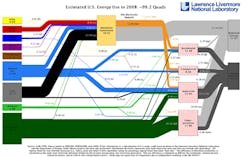What Energy Revolution?
In the April 25th edition of our HVAC Hotmail e-mail newsletter, Service Roundtable CEO Matt Michel wrote a feisty editorial on why Earth Day sucks. Not to necessarily ride on his coattails, but the article evoked a number of comments as well as some interesting social media activity — enough so that I thought I might talk a bit more on the subject of energy and the HVACR Industry.
No matter where you stand on the issue of American energy policy — which is focused on the need for industry and consumers to find ways to use less energy — one thing is very apparent to me: the Green movement has not sparked the revolution it promised back in 2007 and 2008.
If you remember, that is when we began seeing all kinds of coverage in the general media, on TV news, and the Internet about the “Green” wave that was racing toward America and how you better figure out how to ride it or get swept away by it. Even I wrote about it. The revolution was coming.
From where I sit, not much sweeping has actually happened. Sure, everyone talks about energy efficiency today as if they’re quoting a bible. We’ve seen Environmental Protection Agency (EPA) programs born from the ideas behind sustainability and environmental responsibility. We have some more efficient buildings and cars and mechanical systems equipment.
That’s good stuff.
In the April 9th online edition of The Atlantic magazine, Senior Editor Alexis C. Madrigal wrote an article titled “What an Energy Revolution Doesn’t Look Like.” That article really caught my attention. In it he writes that back in 2007 concerns about climate change were growing and the costs for wind and solar technologies was declining.
He wrote, “Fast forward six years, and no revolution has come. Instead, the US energy system looks remarkably like it did in 2008. Overall energy usage has declined a bit—thanks, prolonged economic downturn — but the energy services we get have actually declined more. That is to say, the efficiency of the system has gone down.”
He goes on to explain that today, as a nation, we have very slightly increased our use of natural gas over burning coal to produce electricity, that renewable energy like solar and wind use has increased a bit, and we have slightly decreased our use of oil. But in the end, he says the U.S. energy system “looks remarkably like it did in 2008.”
Earth Day, as Matt Michel points out, began in April 1970 with environmental experts from academia, from industry, and from the government all predicting doom and gloom scenarios based on mankind’s pollution of our environment and taxation of resources to fuel our gluttonous need for electricity, gasoline, and oil.
Earth Day was just the revolution to change all that. One thing is clear today: none of these predictions ever came true — not even close. In fact, EPA admits that. Michel cites a number of their statistics that show from 1980 to 2008, without a great increase in the use of renewable energy sources, emissions of carbon monoxide, ground level ozone, lead, nitrogen dioxide, and sulphur dioxide have declined in double-digit percentages.
Madrigal says these declines and others happened through nothing more revolutionary than our weak economy, not Earth Day-like environmentalism.
I have to admit that perhaps revolution is too harsh of a word. It implies explosive change, like the fabled tidal wave of the green movement that was going to sweep us all away. Instead, it seems to me to be a slow, evolutionary progression that is changing the way we all think about our energy consumption and the pollution of the planet.
As Madrigal concluded, “The great hope for a quick and sweeping transition to renewable energy is wishful thinking. At least in the United States.”
For the HVACR Industry, there is nothing wrong with working toward sustainability as we provide customers with indoor environments where they can be comfortable, productive, healthy, and safe. We also have to work toward eliminating the crazy credibility of all the doom and gloom end-of-the-world tree huggers.


